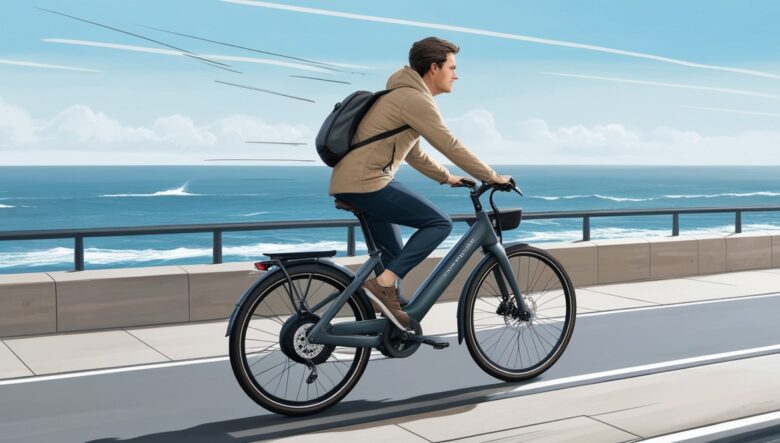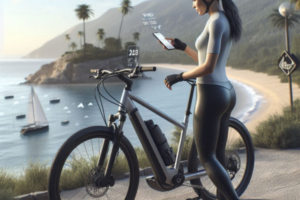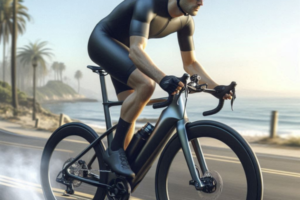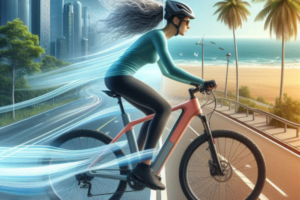🚴♀️ Optimize the Aerodynamics of Your Electric Bicycle in Coastal Environments
Riding an electric bicycle along the coast can be a deeply satisfying experience. The combination of open air, scenic routes, and refreshing ocean breezes makes it a preferred mode of transport for many commuters and leisure riders. But as any coastal cyclist knows, the wind that carries that salty air can also be one of the biggest obstacles to a smooth, efficient ride. In such settings, aerodynamics becomes more than a technical detail—it’s a crucial factor that impacts your speed, stability, comfort, and battery performance.
Aerodynamics refers to how air flows around your body, your bike, and your gear. Coastal environments are particularly challenging due to strong and variable winds, dense humid air, and unpredictable terrain. For e-bike riders, these factors introduce additional drag that forces the motor to work harder, drains the battery faster, and reduces overall performance. The good news? With a few strategic adjustments, you can drastically reduce wind resistance, conserve energy, and make your coastal rides more enjoyable.
🌬️ Why Coastal Environments Are Different
Coastal regions present unique aerodynamic challenges that inland riders may never face. Temperature differences between the land and ocean produce consistent wind patterns—onshore winds during the day and offshore winds in the early morning and evening. These winds can fluctuate rapidly in both strength and direction, making it harder for cyclists to anticipate resistance. Add to that the humid, salty air and exposed roadways along the coast, and it becomes clear why traditional cycling strategies aren’t enough for this terrain.
In cities like San Diego, Barcelona, Sydney, or Cape Town, wind speeds commonly reach 15 to 30 km/h on a typical afternoon. While a traditional cyclist might slow down and push harder, e-bike riders face a different kind of strain—battery drain. That means less range, more frequent charging, and an overall reduction in riding efficiency. The key to overcoming this isn’t to fight the wind, but to work with it using smart aerodynamic choices.
📏 Understanding Aerodynamic Drag
To effectively optimize your setup, you first need to understand aerodynamic drag. Drag is the force that opposes your motion through the air. It increases exponentially with speed, meaning that at 25 km/h (a typical e-bike cruising speed), you’re already pushing against a significant wall of resistance.
There are two primary types of drag:
- Form drag: Caused by the shape and size of objects moving through the air. Your body and bike present a surface that the wind has to move around. The larger or more irregular this surface, the more drag is created.
- Surface drag: Created when air passes over the textures of your clothing, helmet, and gear. Rough surfaces and loose clothing cause turbulence, which increases resistance.
While we can’t eliminate drag completely, we can reduce it. And even a small improvement has a big impact. Studies show that reducing drag by just 10% can improve energy efficiency and extend your e-bike’s battery range by up to 15%. For riders in windy environments, that can mean the difference between arriving on time—or pushing a heavy bike the last kilometer.
🚴♂️ Posture: Your First Aerodynamic Tool
The fastest, most effective aerodynamic improvement doesn’t require buying anything at all—it starts with your riding position. Most casual riders adopt an upright posture for comfort, which is perfectly reasonable in calm conditions. However, this exposes more of your body to headwinds, increasing form drag dramatically.
You don’t need to hunch over like a Tour de France rider to make a difference. Small adjustments in your riding posture can create a sleeker profile and improve your bike’s efficiency in windy conditions.
- ✅ Lower your torso: Bring your chest forward and down slightly to reduce your frontal area.
- ✅ Tuck your elbows: Keep them close to your sides to narrow your shoulder profile.
- ✅ Look ahead with your eyes: Avoid raising your head and neck too high. Use your gaze, not your chin.
- ✅ Relax your upper body: A stiff posture increases fatigue and turbulence.
The goal is to create a natural, sustainable position that reduces drag without sacrificing control or comfort. Practicing this posture on short rides will help you build muscle memory and integrate it into your daily commuting routine.
🧥 Clothing and Gear: Dress for the Wind
Aerodynamic drag isn’t only about your body and bike—it’s also about what you wear and carry. In coastal environments, where gusts and sustained winds are part of daily riding, the wrong clothing can work against you like a parachute. Flapping jackets, hoods, and wide pants increase surface drag and decrease your stability. But with thoughtful wardrobe choices, you can maintain your style, stay protected from the elements, and still improve your aerodynamic profile.
Start with outerwear. A windproof jacket with a snug fit across the arms, chest, and waist will cut through the air more cleanly than a loose hoodie or casual coat. Many modern commuter jackets are tailored for cycling and include ventilation panels, reflective elements, and water resistance—all without adding bulk. If your city experiences sudden rainstorms, opt for a sleek waterproof shell that folds into a saddle bag or rear pannier.
Trousers and shoes also play a role. Wide-leg pants or flowing fabric can flutter and catch the wind. Choose tapered commuter pants or secure cuffs with adjustable ankle straps. For footwear, avoid overly wide or chunky shoes that might interfere with your pedaling efficiency or airflow.
🎒 Say Goodbye to Backpacks
One of the most overlooked sources of drag is the backpack. While convenient, backpacks sit high on your back, disrupt your center of gravity, and create significant turbulence behind you. In crosswinds, a loaded backpack can pull your upper body sideways and affect steering. It also traps heat and increases perspiration.
A better alternative? Use rear-mounted pannier bags. Mounted low on either side of a rear rack, panniers improve weight distribution, reduce drag, and increase comfort. If you’re concerned about quick access to items like your phone or wallet, try a top-tube frame bag with a transparent cover, which provides functionality without obstructing airflow.
📦 Streamlining Your Setup
The accessories on your e-bike can either enhance or hurt your aerodynamic efficiency. Mirrors, bottle cages, baskets, and phone mounts all add wind-catching surfaces. While some are essential, others can be reconfigured or replaced with sleeker options.
- ✅ Use handlebar accessories sparingly. Stick to what’s absolutely necessary and choose compact, rounded designs.
- ✅ Route cables neatly along the frame. Use cable wraps or integrated housing to reduce air disruption.
- ✅ Opt for integrated lighting. Many modern commuter bikes offer frame-integrated lights that preserve clean lines and reduce surface drag.
- ✅ Consider low-profile fenders. These protect you from road spray without creating additional drag like full fenders can, especially in wind.
If you often carry items on your bike, evaluate where and how they’re stored. Baskets mounted on the handlebars or front rack increase drag dramatically. A better solution is to shift storage to the rear triangle of the bike. If you ride with water bottles, choose cages mounted inside the frame triangle rather than on the seat tube, where airflow is more critical.
📊 Gear Aerodynamics Comparison Table
| Item | Aerodynamic Impact | Recommended Alternative |
|---|---|---|
| Backpack | Moderate to high drag | Rear pannier or rack-mounted bag |
| Loose jacket | High surface drag | Fitted windproof commuter jacket |
| Handlebar basket | Very high frontal drag | Rear rack with closed panniers |
| Exposed cables | Moderate drag and turbulence | Frame-routed cables or cable sleeves |
| Bulky helmet with vents | Increased turbulence | Streamlined commuter helmet with rear taper |
🛠️ Routine Maintenance for Aerodynamic Performance
Maintenance may not seem like an aerodynamic factor—but it absolutely is. Rolling resistance from underinflated tires, drag from misaligned brakes, or friction in a dirty drivetrain can negate all your other aerodynamic gains. Coastal conditions accelerate wear, corrosion, and grime, so preventive care is not optional—it’s essential.
- 🔧 Check tire pressure weekly. Underinflated tires increase drag and reduce stability.
- 🧽 Clean your chain and drivetrain regularly. Salt and sand buildup increase resistance and wear.
- 🛢️ Lubricate with rust-resistant oil. Choose products made for wet, humid climates to protect moving parts.
- 🛞 Inspect wheel trueness and bearing function. Misaligned wheels or sticky bearings disrupt airflow and efficiency.
Think of your e-bike as a system. A clean, smooth-rolling machine naturally reduces energy loss and handles wind more confidently. Plus, you’ll extend the life of your components and reduce the need for costly replacements.
📱 Technology That Improves Aerodynamic Efficiency
Modern electric bike commuting isn’t just about physical setup—it’s also about leveraging digital tools to enhance performance. In coastal environments, real-time wind data and performance tracking can help you make smarter decisions and stay ahead of changing conditions. With the right apps and devices, you can monitor aerodynamic impact, adjust your route, and avoid excessive battery use caused by headwinds.
Here are a few tech tools every coastal e-biker should consider:
- Windy (App): View wind maps, gust speeds, and directional trends by the hour. This helps you decide the best time to leave, or whether to switch to a more sheltered route.
- Strava or Komoot: Track performance over time and analyze how your speed or range changes with wind, route, and riding posture. Komoot also helps you plan bike-friendly, low-wind routes.
- Bosch Flow App (for Bosch e-bikes): Offers detailed motor data and battery consumption analytics, which help you identify if resistance is impacting performance more than expected.
- Garmin Edge Devices: Cyclists using performance meters can pair devices that estimate aerodynamic drag (CdA) based on power and speed data.
Technology doesn’t replace good habits, but it empowers you to track progress, test changes, and ride smarter over time. Even something as simple as checking wind direction before leaving home can reduce your physical effort and battery consumption.
🧠 Real Commuter Story: Rafael from Porto
Rafael is a 40-year-old designer who rides 9 km each way along the coast of Porto, Portugal. His e-bike is his daily transport to his creative agency. Initially, he wore casual jackets and carried his laptop in a shoulder bag. The strong afternoon winds made the return leg of his trip exhausting—his battery often dropped from 60% to 10%, and he had to reduce speed to avoid fatigue.
After learning about wind optimization strategies, Rafael made several changes: he installed rear panniers, started checking the Windy app every morning, adjusted his posture to a slight forward lean, and replaced his baggy outerwear with fitted commuter gear. Within two weeks, he extended his range, reduced his battery use by 25%, and arrived home feeling less tired. “The biggest change wasn’t my bike,” he says. “It was how I ride and when I ride.”
📍 Coastal Route Planning for Reduced Drag
Wind is geography’s wildcard. Coastal roads that offer beautiful views often come with heavy wind exposure. Smart route planning is essential to avoid stretches where gusts slow you down, destabilize your bike, or force your motor to work harder.
Tips for planning more aerodynamic coastal rides:
- ✅ Ride during off-peak wind hours. Early mornings often offer the calmest conditions in coastal cities.
- ✅ Avoid waterfront boulevards on days with wind speeds above 20 km/h unless riding with a tailwind.
- ✅ Use urban corridors or tree-lined paths for natural shielding from crosswinds.
- ✅ Adapt your route based on wind direction. Plan headwind segments early when your energy and battery are fresh.
Try using wind as an ally. If your city has a loop-style commuting route, ride the wind-exposed leg outbound and return home with a tailwind. It can feel like your motor suddenly got an upgrade.
🛒 Smart Budget Upgrades That Improve Aerodynamics
You don’t need to spend a fortune to reduce drag. Many aerodynamic improvements are low-cost or even free. Below is a breakdown of upgrades and their approximate impact:
| Upgrade | Estimated Cost | Benefit |
|---|---|---|
| Fitted windproof commuter jacket | $60–$80 | Reduces surface drag from loose clothing |
| Rear panniers + rack | $80–$120 | Improves weight distribution and reduces backpack drag |
| Integrated front/rear lights | $20–$40 | Eliminates bulk of clip-on accessories |
| Cable wraps or internal routing | $10–$25 | Minimizes turbulence caused by loose cables |
| Compact mirror or helmet-mounted mirror | $15 | Reduces frontal drag compared to large side mirrors |
Focus your budget on items that balance visibility, safety, and aerodynamics. Many commuter products now combine reflectivity, weather protection, and streamlined shapes—so you don’t have to choose between form and function.
✅ Pre-Ride Checklist for Coastal Commuters
Before heading out on your daily ride, it’s helpful to run through a quick checklist to ensure your setup is optimized for aerodynamic performance—especially in coastal environments where conditions can change quickly. This habit helps you stay safe, efficient, and consistent.
- ✔️ Tire pressure: Inflate tires to the recommended PSI for reduced rolling resistance and better traction.
- ✔️ Clothing check: Make sure all garments are zipped, snug, and weather-appropriate to reduce surface drag.
- ✔️ Secure accessories: Double-check that bags, lights, and tools are firmly attached and do not flap or protrude.
- ✔️ Wind and weather forecast: Use apps like Windy or your local meteorological service to adjust your route or departure time if needed.
- ✔️ Battery check: Ensure your e-bike is fully charged if you expect strong headwinds or longer routes.
Just five minutes of preparation can lead to a more comfortable and efficient ride. As a coastal commuter, adapting to your environment isn’t just smart—it’s necessary.
🌬️ Understanding the Wind: Friend or Foe?
Coastal winds can be powerful, unpredictable, and either helpful or exhausting—depending on how you approach them. Understanding the types of wind and how they affect your riding dynamics is a hidden skill every coastal e-biker should develop.
🔄 Headwinds
These are winds blowing against your direction of travel. They create the most drag and lead to increased motor usage and battery drain. The key is posture: lower your torso and keep a compact profile. Riding into a headwind early in your trip (when your battery and energy levels are fresh) can make the return journey easier.
🌬️ Tailwinds
Tailwinds are every cyclist’s best friend. They push you forward and reduce drag. Use tailwind segments to increase your average speed with minimal effort or conserve battery by lowering motor assist. Plan these for the second half of your ride if possible.
↔️ Crosswinds
Crosswinds can be destabilizing, especially when they come suddenly from the side. To stay safe, reduce your frontal profile and lower your center of gravity by leaning slightly into the wind. Be extra cautious when passing gaps between buildings or trees, where gusts may hit unexpectedly.
Your response to wind should be dynamic. Practice adjusting your posture and grip based on wind direction to maintain stability and efficiency in all conditions.
📣 Visibility vs. Aerodynamics: Finding the Balance
One of the most important principles for any e-bike commuter is that aerodynamics should never compromise visibility or safety. Fortunately, today’s cycling gear makes it possible to improve both at once.
Here’s how to stay visible while remaining aerodynamic:
- 🧥 Reflective details on tight-fitting clothing: Look for jackets and pants with embedded reflective stripes or piping that don’t flap in the wind.
- 💡 Low-profile LED lights: Use slim, USB-rechargeable lights that mount flush to your helmet or frame.
- 🪞 Compact mirrors: Use bar-end or helmet-mounted mirrors instead of large side mirrors that increase drag.
- 🎒 Reflective panniers: Many rear bags now include reflective materials while maintaining a sleek design.
Never sacrifice safety for performance. The best aerodynamic setup is one that helps you ride faster and arrive safely at your destination. Visibility gear that’s built into your aerodynamic profile is the smartest investment you can make.
📚 Bonus Tip: Wind as Training Tool
While wind is often viewed as a challenge, you can also use it to build strength and efficiency. Consider doing short rides on windy days to practice posture, route adaptation, and battery management. Over time, you’ll develop muscle memory and strategic instincts that make you a stronger rider—even in perfect conditions.
Many coastal riders report that after several weeks of conscious wind training, their commutes become more predictable and less draining. Treat wind not as your enemy, but as a variable to master.
📉 The Hidden Costs of Poor Aerodynamics
Failing to address aerodynamic inefficiencies doesn’t just make your ride harder—it affects every part of your e-bike experience. In coastal environments, neglecting posture, clothing, maintenance, or wind planning means you’ll face constant resistance. That resistance translates into:
- ⚡ Reduced battery range: Headwinds and drag force your motor to work harder, draining your battery faster.
- 🛠️ Increased wear on components: More effort means more strain on your drivetrain, tires, and bearings.
- 😓 Greater rider fatigue: Even with pedal assist, fighting wind makes you work harder and arrive more tired.
- ⏱️ Longer commute times: Drag reduces your average speed, especially on flat, open stretches of road.
In contrast, a properly optimized setup helps you conserve energy, arrive refreshed, and save on long-term maintenance. It’s not about racing—it’s about efficiency and enjoyment.
🎯 Final Thoughts: Aerodynamics for Everyday Riders
Aerodynamic optimization isn’t reserved for professional cyclists or weekend racers. It’s a powerful tool for everyday electric bicycle commuters—especially those living and riding in coastal cities where wind is a constant companion. With small, strategic changes to how you ride, dress, equip, and plan your route, you can dramatically improve your riding experience.
You don’t need to spend a lot to see results. Start with the basics:
- ✔️ Adjust your riding posture to reduce frontal area
- ✔️ Choose fitted, wind-resistant clothing with reflective elements
- ✔️ Replace backpacks with rear-mounted storage
- ✔️ Secure or streamline your bike’s accessories
- ✔️ Check wind forecasts and adapt your route when possible
As these habits become part of your routine, you’ll notice subtle but meaningful changes—longer battery life, steadier control, improved safety, and faster, more relaxed commutes. Aerodynamic awareness is a commuter superpower, and it’s now part of your toolkit.
💬 Join the Coastal E-Bike Community
Do you ride your e-bike along coastal roads or windy urban routes? What aerodynamic tips or upgrades have made the biggest difference for you? We’d love to hear your insights and stories. Whether you’re a new rider or a seasoned commuter, your experience can help others find smarter, safer, and more energy-efficient ways to ride.
Drop your thoughts in the comments and share this guide with fellow e-bike commuters. Together, we can build a stronger, more informed coastal cycling community—one smart ride at a time.



